Preface: On July 15, 2017, large areas of Idlib province and its countryside witnessed clashes and military confrontations between Ahrar al-Sham al-Islamiyya[1] on one hand and Hayat Tahrir al-Sham/HTS[2] on the other hand. The confrontations erupted between the two sides after intense arguments and mutual provocations between them, as each one desired to control as more as possible of the center of Idlib province, Syrians for Truth and Justice-STJ researchers informed.
The confrontations included most of Idlib province from the north to the south and from the east to the west, resulted in dozens of civilian casualties and injuries, and ended in HTS controlling the entire Idlib with large areas of its countryside until July 23, 2017, followed by Ahrar al-Sham al-Islamiyya withdrawal from the areas and an agreement between them whose some terms stated a cease-fire and a releasing of prisoners from both sides, STJ reported.
Earlier, the province had witnessed outbreak of clashes between Ahrar al-Sham al-Islamiyya and HTS- al-Nusra Front- in 2016, against the backdrop of settling scores and attempts to extend control on the city. However, these clashes came after an earlier close alliance between them, which led to control the whole Idlib in summer 2015, according to STJ reporter.

Map shows HTS-controlled areas in Idlib and its countryside until August 15, 2017. It also shows the Syrian armed opposition factions-controlled areas in Idlib and its countryside.
Photo Credit: Omran Center for Strategic Studies.
First: Exchanging Statements between the two Parties
On Saturday, July 15, 2017, Ahrar al-Sham al-Islamiyya issued a statement about the continued flow of crowds of HTS to many areas with a view to step forward to Saraqib, east of Idlib, in addition to areas in Jabal al-Zawiya despite having a joint and an agreed “Sharia ruling” between the two parties. Moreover, the statement said it ‘would repel vigorously any attack that might target its sectors’, referring to the recent escalation between the two parties in north Syria.
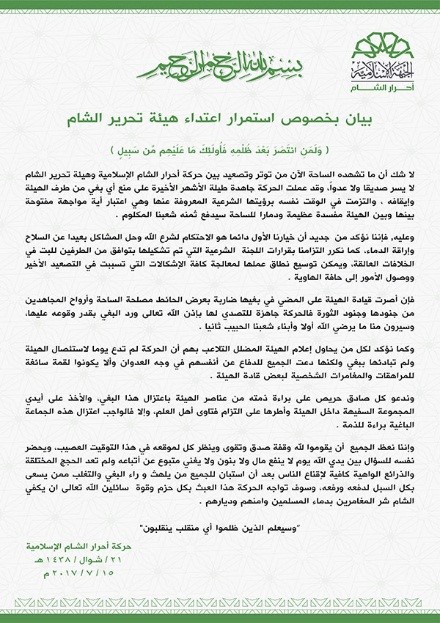
Image of the July 15, 2017 statement issued by Ahrar al-Sham al-Islamiyya in which it stated non-stop aggressive acts by HTS and that it would repel vigorously any attack that might target its sectors.
Photo credit: the official Facebook page of Ahrar al-Sham al-Islamiyya
In turn, Moawiyia al-Hashmi, the military commander of al-Badia Sector[3] affiliated to HTS, denied recruitment of any military reinforcements to storm Saraqib city and Jabal al-Zawiya, in a press statement released on July 15, 2017, by Ibaa News Agency, loyal to the HTS, and he disclaimed what Ahrar al-Sham al-Islamiyya had published on its official site. He also spoke in his statement about the reasons of the disagreement with Ahrar al-Sham al-Islamiyya that evolved confrontations between both sides later. Anyway, he said the problem began when a leader of Ahrar al-Sham al-Islamiyya prevented the “maintenance workers” from repairing the power lines at Ras Al Ain power plant near Saraqib on pretext that it follows the General Department of Services. As a result, HTS arrested that leader, and when it communicated with the deputy commander-in-chief of Badia al-Sham affiliated to Ahrar al-Sham al-Islamiyya in order to solve the problem, he refused and stressed that the solution would be to install checkpoints run by Ahrar al-Sham al-Islamiyya and to arrest agents of HTS.
Moawiyia al-Hashmi also asserted that on July 14, 2017, Ahrar al-Sham al-Islamiyya arrested a military commander affiliated to HTS along with his escorts in Tal al-Tofan in Idlib countryside, he stated that agents of Ahrar al-Sham al-Islamiyya had spread among civilians and commenced shooting at HTS elements. As a result, HTS besieged Tal al-Tofan, until a committee was formed to resolve the dispute and the agreement was to release the prisoners and for Ahrar al-Sham al-Islamiyya to withdraw from the town.

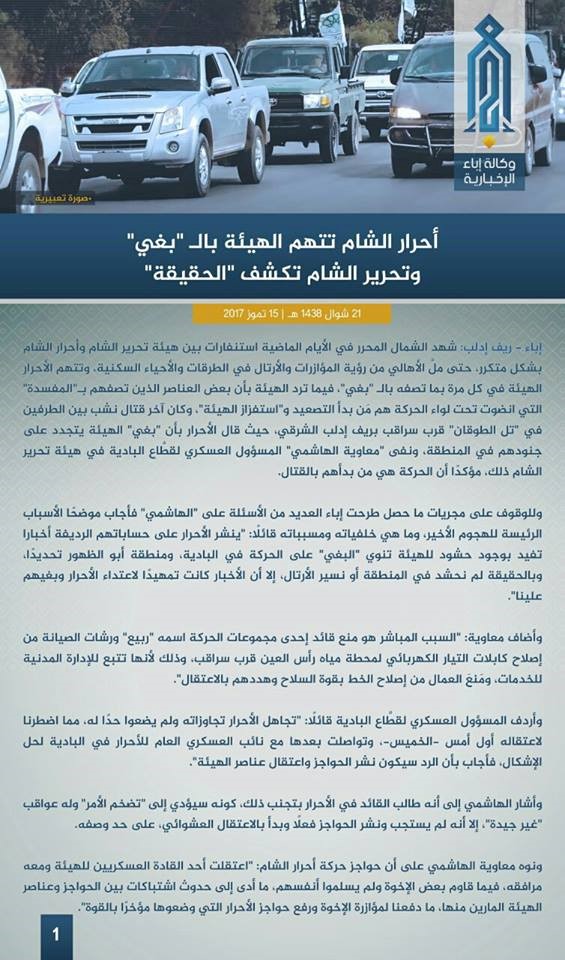
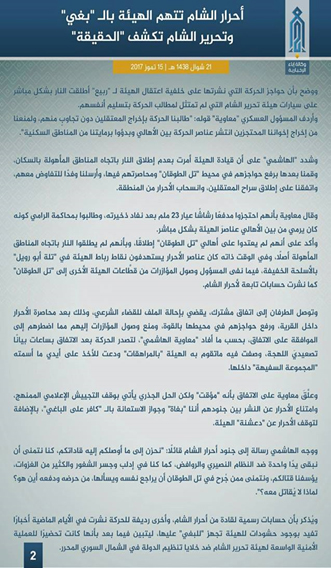
Image shows the press statement released July15, 2017 by Ibaa News Agency, loyal to HTS, by Moawiyia al-Hashmi, the military commander of al-Badia Sector, who denied having any military reinforcements to advance to Saraqib and Jabal al-Zawiya, and he talked about the reasons of the disagreement with Ahrar al-Sham al-Islamiyya.
Photo Credit: Ibaa News Agency Telegram account.
Second: The Intensified Confrontations and Details of Shooting Demonstrators in Saraqib by HTS
Sunday, July 16, 2017, confrontations raged between Ahrar al-Sham al-Islamiyya and HTS, the clashes evolved by using medium and heavy weapons in many areas in Idlib from Habit town and Khan Sheikhoun in the south, passing Jabal Zawiya and Ad Dana and Sarmda towns in the north. The two parties tried to extend control on the province, in this regard Omar Alwan, an activist of Saraqib, told STJ:
“This situation continued until Wednesday, July19, 2017, as the military confrontations between the two parties became fiercer and the military machinery entered heavily. The military boots between the two parties began with firing mortar shells without regard to t civilians within their areas. On Wednesday morning, the people of Saraqib heard sounds of heavy gunfire from the attack by HTS on Ahrar al-Sham al-Islamiyya points, coinciding with the local council elections in Saraqib. Anyway, the confrontations continued until Wednesday afternoon, until Ahrar al-Sham al-Islamiyya fighters finally withdrew from Saraqib, and HTS took full control on the city, then carried out a campaign of arrest[4], and stormed houses belonging to Ahrar al-Sham al-Islamiyya agents.
Alwan added that following HTS control over Saraqib, its agents forced some young men to lower the revolution flag, thus causing a large popular rag, as anti-HTS policy demonstrations swept Saraqib demanding the full withdrawal of HTS from the city, and handing it over to Saraqib Revolutionary Front/ Jabhat Thwar Saraqib[5]. Moreover, the demonstrations continued until Wednesday evening, July 19, 2017, as thousands of people in the city flowed asking HTS to get out, so its elements shot the demonstrators indiscriminately. Alwan detailed saying:
Shooting the protesters by HTS led to the death of the activist Musa’ab al-Ezo from Saraqib who participated in the demonstrations against the Syrian regime from the beginning of eruption of the revolution, as well as caused several injuries. Up to 4,000 demonstrators huddled in the squares, chanted against HTS, and then went towards to the Sharia Court trying to break into amidst gunfire by HTS officers stationed at the Sharia Court and its surrenders. However, the officers were unable to face thousands of angry young men who did stormed the courthouse, as a result, HTS elements withdrew from the city on July 21, 2017.
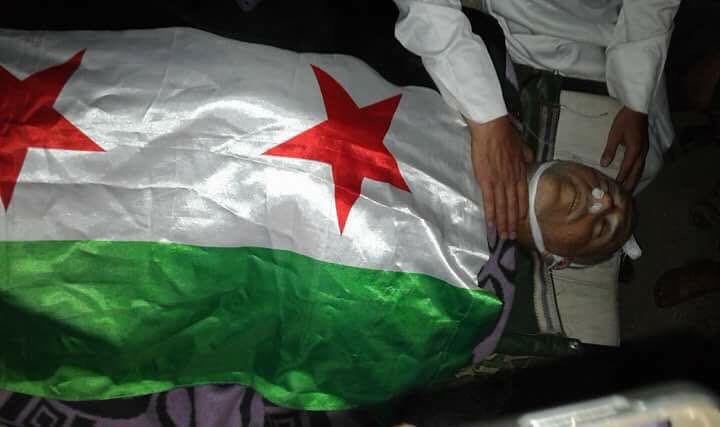
 Image of the activist Musa’ab al-Ezo following his death on 19 July 2017, by HTS agents as a result of their shooting at demonstrators in Saraqib.
Image of the activist Musa’ab al-Ezo following his death on 19 July 2017, by HTS agents as a result of their shooting at demonstrators in Saraqib.
Photo credit: Activists from the city.
An activist from the city, who refused to disclose his name for security purposes and preferred to use the alias Ahmed al-Idlebi, said in his testimony to STJ about the incident:
"Many emirs of Ahrar al-Sham al-Islamiyya insisted not to leave Saraqib including Abu Azzam Saraqib, Emir of Liwaa al-Mouthana who was waiting for support from some of the movement's headquarters, which were falling into the hands of HTS, but there had also been attempts by the movement to avoid fighting with HTS.
When the situation worsened in general and was gradually out of control following HTS took control over the "grain silos headquarter", one of the most important headquarters and warehouses of Ahrar al-Sham al-Islamiyya, besides controlling another headquarter within the city as well as controlling the "radio headquarter", then leaders of the movement along with Abu Azzam Saraqib, the leader of Liwaa al-Mouthana, were forced to enter the headquarter of " Saraqib Revolutionary Front”, after HTS sieged Saraqib, in order to protect themselves from arrest by HTS given Saraqib Revolutionary Front remained impartial in the fighting between the two factions.
However, HTS raided the headquarter of "Saraqib Revolutionary Front", arrested leaders of the movement, vandalized the headquarter, shot at all the offices inside and stole the weapons, but several leaders of Ahrar al-Sham al-Islamiyya managed to escape including the security officer of Liwaa al-Mouthana whose nickname is Abu Muhammad Furqan and another security commander".
Against this background, the civilians in Saraqib joined mass demonstrations near Saraqib Revolutionary Front headquarter, asked HTS to leave the city during which it was raiding the headquarter to arrest the movement leaders. However, HTS faced the demonstration with live bullets, killed the activist Musa’ab al-Ezo and injured two others.
The next morning, following the full control over Saraqib, HTS assaulted and arrested some movement personnel, including the security command, “Abu Ali Sha’aban”, in addition, it controlled the headquarter of the Sharia Court of Ahrar Al-Sham al-Islamiyya, expelled its officers and lowered the revolution flag from the radio pole in Saraqib and from the entrance of the city (in conjunction with the burning of one of the courtrooms that contained files and documents), but HTS said that it did not burn any files or documents and considered the incident against “unknown persons” who exploited the clashes between the two parties.
When HTS controlled the Sharia Court, other mass demonstrations were held in Saraqib to demand the expulsion of HTS who in turn met the demonstrations with indiscriminate shooting to disperse the demonstrators, but because of the demonstrators' insistence and their large numbers, HTS asked for support from agents of the newly controlled- silos grain headquarters in order to help the armed agents to get out of "the Sharia Court headquarter", all of this included heavy gunfire to open a passage to get out and leave the city towards the silos grain headquarter 3 km south of Saraqib.”
And here, it is important to emphasize that those who stormed the city were fighters from "al-Shaitat Tribe" who came from one of the largest headquarters of HTS located in Abu al-Duhur Airport, in addition to the presence of fighters from Saraqib itself who had joined HTS in previous periods and who helped the strange fighters to know the houses of many people and to identify the streets of the city."

Another image shows the withdrawal of HTS fighters from Saraqib on 21 July 2017, against the backdrop of popular rage and demonstrations by the locals.
Photo Credit: Activists from the city.
According to STJ reporter, the situation remained calm in Saraqib especially after an agreement reached between Ahrar al-Sham and HTS on 26 July 2017, when they agreed to end the confrontations, release the captives and stop the incitement through media between them in Jabal Zawiya and other areas including Saraqib, but on Thursday 27 July 2017, a force from HTS re-stormed the headquarter of the Sharia Court in Saraqib, and re-lowered the revolution flag which had been raised earlier until it managed to extend its control over the Sharia Court and then over the city.
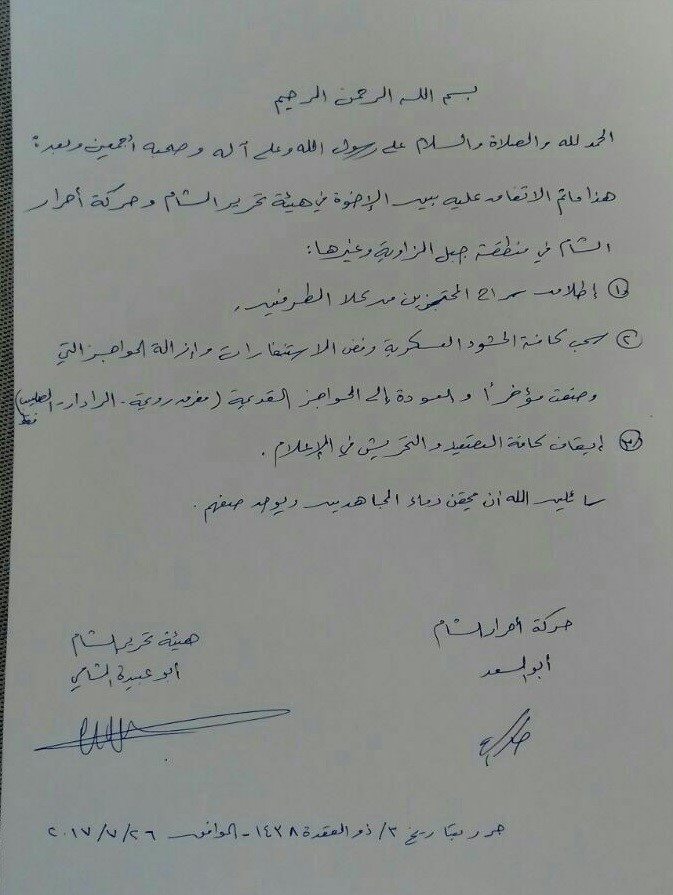
An image shows the agreement between Ahrar al-Sham and HTS in Jabal Zawiya and other areas, including Saraqib, on 26 July 2017, according to which they agreed to end the confrontations, release the captives and stop the incitement through media between them.
Photo Credit: Activists from the city.
Third: Civilian Deaths and Injuries in Clashes between HTS and Ahrar al-Sham
As a result of the expansion of the military confrontations between Ahrar al-Sham al-Islamiyya and HTS in Idlib and its countryside, a number of civilian deaths and injuries were reported, that what Muhammad al-Daher confirmed, the director of Ma’arat al-Nu’man Media Center in Ma’arat al-Nu’man located in Idlib countryside, he told STJ:
"Dozens of civilians were killed and wounded as a result of military clashes and indiscriminate shootings between the two parties; one of the dead was a medic identified as Yusuf Ismail Fadl from Iblin village in Jabal Zawiya, he was killed on 18 July 2017, in addition to the child Subhi Ibrahim Musa from Shinan village in Jabal Zawiya who was killed on 19 July 2017, as well as killing the young man Mustafa Issam al-Din, from Hazano village in the northern countryside of Idlib on 20 July 2017, was documented.”
In a related context, a videotape published by Khotwa (Step) News Agency on 21 July 2017, showed a woman from Benin village in Jabal Zawiya, telling what happened to her family in the recent confrontations between Ahrar al-Sham and HTS, she said that her husband and daughter were killed by fighters of a checkpoint operated by HTS, and noted that one of her children was seriously injured as a result of shooting him while the family was trying to flee to Ma`arat al-Nu`man, following the takeover of HTS on their village, Benin, where she said:
"The agents of the checkpoint began firing at us, my husband was screaming and saying "I'm a civilian" and asking them not to shoot because his children were with him, but they did not respond to his pleas, and the bullets pierced his body and he died. Moreover, they killed my eldest daughter with five bullets, while my youngest daughter identified as Mays was seriously injured causing a complete paralysis in her limbs.”
According to STJ reporter, the clashes also caused an explosion of a bomb-laden car near “Dawar al-Mazra’a" area in Idlib on 23 July 2017, where the bombing targeted a gathering of HTS agents, resulting in dozens of dead and wounded of HTS fighters, as well as killed and injured several civilians.
Fourth: Ending the Confrontations and the Control of HTS over the Entire City of Idlib and Large Areas of its Countryside
On 23 July 2017, HTS managed to extend its control over the entire Idlib (Province center) and large areas of the countryside, except the villages of Jabal Zawiya[6] and the villages of Jabal al-Wastani[7], following the withdrawal of Ahrar al-Sham al-Islamiyya to areas in the northern countryside of Hama, after an agreement between the two parties which included the withdrawal of Ahrar al-Sham from Bab al-Hawa crossing border that was controlled on 20 July 2017 in order to surrender it to a civil administration; the agreement also included the return and work by the Friday Agreement which was signed between the parties on 21 July 2017. However, the parties did not adhere to it that time so the confrontations between them were renewed, the agreement as well included a cease-fire and the release of the prisoners[8] from both sides.

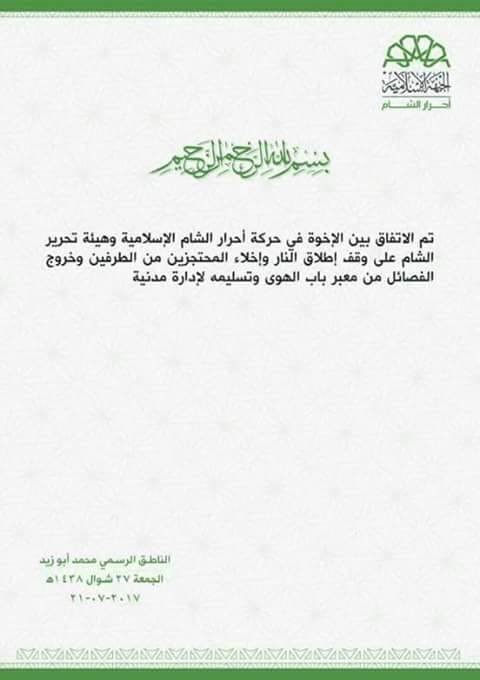
An image shows the first agreement between Ahrar al-Sham and HTS on 21 July 2017, which included a cease-fire and the release of prisoners from both sides, however, this agreement was not implemented and the confrontations renewed between the two parties.
Photo Credit: the official page of Ahrar al-Sham .
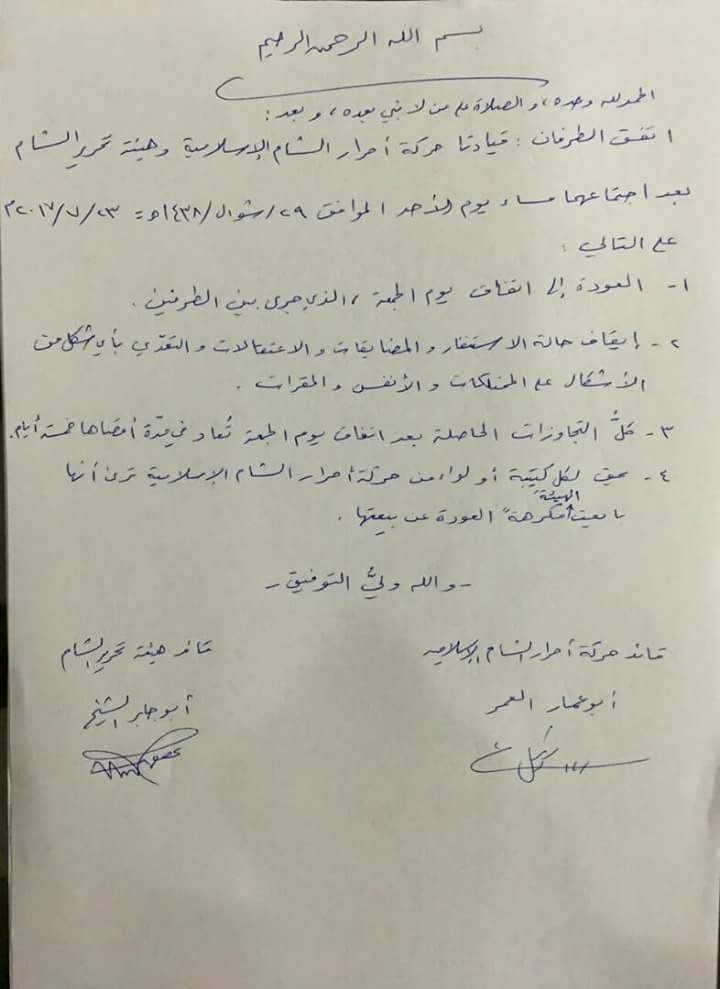
Image shows the second agreement between HTS and Ahrar al-Sham on 23 July 2017, which ended the fighting between the two parties and the return of the first agreement, as well as stopped the arrests and the state of alert between them.
Photo Credit: Activists from the countryside of Idlib.
According to STJ reporter, locals of Idlib and its countryside are still fearful of renewing the military confrontations as the region is experiencing a state of instability and congestion, especially that Ahrar al-Sham had announced on August 1, 2017, the resignation of its former leader Ali al-Omar and the appointment of a new leader identified as Abu al-Baraa.
[1] It was formed on November 11, 2011, with approximately 25,000 combatants, it actives in Aleppo and some areas of Idlib and is currently headed by Hashim al-Sheikh, but there are reports on dismissing him and appointing Abu al-Baraa instead.
[2] On January 28, 2017, several jihadist factions in northern Syria announced their integration under the name Hayat Tahrir al-Sham/HTS. They are Jabhat Fateh al-Sham, formerly al-Nusra Front, Nour al-Din al-Zenki Movement, Liwaa al-Haqq, Ansar al-Din Front, and Jaysh al-Sunna. However, against the backdrop of the recent clashes between Ahrar al-Sham al-Islamiyya and HTS in the north of the Syria on July 15, 2017, Nour al-Din al-Zenki Movement announced separating from the integration on July20, 2017.
[3] It includes eastern Idlib, specifically east of Saraqib, east of Senjar, east of Aleppo to Raqqa and to the Iraqi border, as well as eastern Hama to the Syrian Badia, the Iraqi border and to the eastern countryside of Homs.
[4] According to another witness, the arrests took place several days after taking control of the city. They arrested civilians on the pretext of their commercial dealings with Ahrar al-Sham al-Islamiyya, and also arrested members of Ahrar al- Sham al-Islamiyya.
[5] It Announced its formation on October 3, 2012 under the name of the Jabhat Thwar Saraqib, comprising a group of armed brigades from Saraqib, they are the Martyr Asaad Hilal Battalion/ aLshahid Asad Al-Hlal, Martyr Mohammed al-Haf Battalion, al-Furqan Battalion, Saraqib Martyrs Battalion, al-Hussein Battalion, Sultan Mohammed al-Fateh Battalion, and Usud Allah Battalion.
[6]Such as the towns of Ihsim, Iblin, Blion, al-Rami, Marayan and al-Bara, given they remained under the control of Ahrar al-Sham.
[7]Such as the towns of Mishmishan, Ein Elsoda, al-Bishria, al-Kastan and Bzeit, given they remained under the control of Ahrar al-Sham.
[8]A special source told STJ said that HTS did not release the prisoners of Ahrar al-Sham al-Islamiyya until 18 August 2017, including Abu Azzam Saraqib, Emir of Liwaa al-Mouthana and Abu Ali Shaaban, the security commander.

